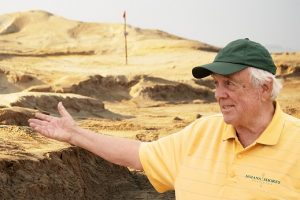Most businesses would be concerned if their best customers were growing old. In golf tourism, it’s an indicator that the good times are going to keep on rolling for the next decade or longer.
The last of the roughly 75 million baby boomers turn 55 in 2019, they have accumulated nearly 80 percent of the nation’s personal net worth and they are intent on enjoying the good life.
“This is a generation that experienced the largest transfer of wealth in human history,” said Sam Baker, founder of tour operator Haversham & Baker. “So the older they get, people in our customer base have more disposable income because as they age they don’t have kids in college, and they’re spending it on themselves.”
The cornerstone of golf tourism always has been the buddy trip – typically four or eight guys (and it’s almost always guys) touring Scotland or Ireland, knocking off as many trophy links as possible, closing down the pubs in the evenings. That’s not going to change anytime soon.
“Most of us have been riding that wave for 30 years,” Baker said.
But as the boomers push into their 60s, more couples are traveling together, and that has ramifications for how much golf they play, how they travel, where they stay and what they expect from their experiences.
Baker said that five years ago, couples accounted for 10 percent of his business. It’s now 20 percent, and “we see that steadily increasing.”
Unlike buddy trips, couples aren’t booking 36 holes a day; they might even take some days off for sightseeing.
“It’s more experience-related and less hardcore golf,” said Bill Hogan, senior vice president of sales for Garmany Golf. “People aren’t as interested in those commando trips as they were in the past.”
Tour operators are spending more time creating unique experiences for their clients. Baker suggests such things as making gin at Kingsbarns Distillery near St. Andrews, Scotland, or dinner with the chieftain of Clan Fraser at his castle in the Scottish Highlands.
“In the luxury space, and particularly if the economy stays strong, if the dollar stays strong, the whole idea about an experience is going to become more refined,” said Gordon Dalgleish, co-founder of tour operator PerryGolf.
Baker points to Gus Hillenbrand as an example of the shift in his business. Hillenbrand has been a Haversham client for nearly 20 years, typically traveling with buddies, sometimes playing 36 holes a day, enjoying the pubs in the evenings. Last year Hillenbrand and his wife, Nancy, decided, along with some friends at Ocean Reef Club in Key Largo, Fla., to do a couples trip to Scotland.
“The women added a completely different dimension,” Hillenbrand said. “The women are game for almost anything and they always want to see different things. It makes it more fun.”
Leisure golf trips to Asia from the U.S., including Vietnam (above) are expected to increase in the future. (Cam Ranh Golf Links)
He said the wives were heavily involved in setting the itinerary, which included less golf and more side trips, such as castle tours. “I wouldn’t do that with the guys,” he said. “I would just play a lot more golf with the guys.”
He still plans future trips with his golf buddies, but also expects to do more couples trips.
“Being with the wives was just a treat,” he said.
Many of the baby boomers are flush with cash and unwilling to compromise. At the high end of the spectrum, Hogan sees continued growth in private air travel. When they reach their destination, Dalgleish said, “They want everything done for them from the time they get off the plane to the time they get back on the plane.”
These clients won’t scrimp on quality, and that impacts decisions on where they stay.
A year ago, Baker didn’t view Adare Manor in County Limerick, Ireland, as a good fit for his clients. The resort is an hour from Ballybunion and Lahinch, and 90 minutes from Tralee – some of the closest trophy links. The resort’s golf course, a Robert Trent Jones Sr. parkland layout, wasn’t on tourists’ must-play lists.
Adare Manor, however, reopened to widespread praise this year following a teardown and rebuild by owner J.P. McManus, who bought the resort in 2014. McManus also brought in Tom Fazio to remodel the course in hopes of landing the 2026 Ryder Cup. Now Baker views the uber-luxe resort as ideal for couples seeking “good-life experiences.”
Baker points to other resorts – Dromoland Castle and K Club in Ireland, and Trump Turnberry and Gleneagles in Scotland – that recently poured tens of millions of dollars into renovations. They wouldn’t necessarily be primary options for buddy trips, but they’re tailor-made for couples who demand Five Star accommodations.
“Over the next five years, you’re going to see more of a trend toward luxury because that’s where the demographics are pushing it,” Baker said. “If that’s not the future, then a lot of smart people are doing dumb investments.”
As the couples segment of the travel market grows, so too does the demand for ever more exotic adventures.
“If the husband says, ‘I’m going to Scotland with the guys,’ the spouse isn’t likely to say, ‘Oh, no you’re not,’” Dalgleish said. “But if the husband says, ‘I’m going to South Africa or Australia with the guys,’ the spouse is probably going to want to go along.”
Aside from South Africa and Australia, Hogan said he sees growing demand for destinations such as northern Italy, Portugal, Sweden and Holland. He has high hopes for Southeast Asia over the next decade, particularly Vietnam.
“The tourism infrastructure, the golf resorts and golf courses that are being built are fantastic, and the value for money is among the best in the world,” Hogan said. “I think Vietnam has the potential to be a real hot destination.”
Regardless which destinations they choose over the next decade, these affluent boomers are going to want nothing but the best. Gwk
(Note: This story appears in the December 2018 issue of Golfweek.)
The article "Future of Golf: Top-shelf travel becomes goal of baby boomers" was originally published on https://golfweek.com/2018/12/27/future-of-golf-top-shelf-travel-becomes-goal-of-baby-boomers/?src=rss





